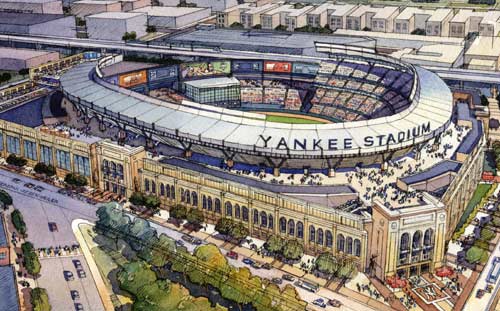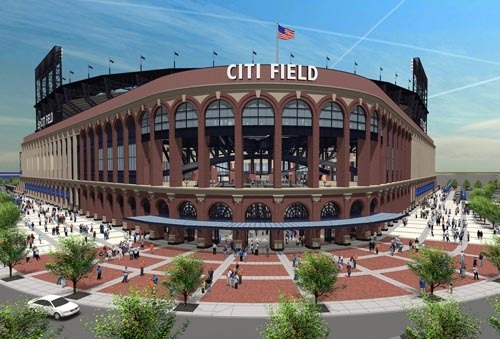[翻譯]Two New Baseball Palaces, One Stoic, One Scrappy


幾乎同時動工、同時啟用、同樣企圖找回歷史、設計還出自同一個建築事務所的兩個備受矚目新球場, 最終呈現在世人面前的成果卻大異其趣
Architecture Review
Two New Baseball Palaces, One Stoic, One Scrappy
By NICOLAI OUROUSSOFF
Published: April 3, 2009 / The New York Times
American stadium design has been stuck in a nostalgic funk, with sports franchises recycling the same old images year after year.
目前美國的運動場設計颳起了一股復古風, 球隊經營者們試圖從記憶中找回熟悉的影像重新融入新設計中。
Still, if you have to go with a retro look, New York City could have done worse than the new Yankee Stadium and Citi Field. Both were designed by Populous (formerly known as HOK Sport Venue Event) and are major upgrades over the stadiums they replaced, which had been looking more and more dilapidated over the years. Both should be fine places to spend a few hours watching a game.
對於這樣的球場設計趨勢, 即將有兩個新球場啟用的紐約將提供最好的範例, 新洋基球場和花旗球場 (Citi Field) 都是由Populous建築師事務所 (也就是過去的HOK Sport Venue Event) 操刀設計, 和其所取代的舊球場相比也都有著顯而易見的品質提升, 這兩個新球場都將會是球迷享受觀看比賽樂趣的好地方。
What’s more, each stadium subtly reflects the character of the franchises that built them. Yankee Stadium is the kind of stoic, self-conscious monument to history that befits the most successful franchise in American sports. The new home of the Mets, meanwhile, is scrappier and more lighthearted. It plays with history fast and loose, as if it were just another form of entertainment.
兩個球場的設計也反映出扮演其幕後推手的兩個球團截然不同的特質和形象。洋基球場是個沉穩、對自己的歷史意義有自覺、被一支美國運動史上最成功球隊視之為"家"的紀念性建築。而大都會的新家花旗球場, 則有著較為活潑、令人愉悅的外觀設計, 歷史元素對於花旗球場來說, 只不過是讓其設計更具娛樂性的包裝。
Yankee management started talking about replacing the old stadium more than a decade ago, and this seemed to be the tougher challenge: the stadium sparkled with the memories of 26 World Series championships. Architecturally, however, the stadium was charmless. Renovation in the 1970s may have made it more comfortable (fans loathed the painful wooden seats of the original version), but it also destroyed many architectural features. The original copper frieze that lined the stadium’s upper deck was ripped out. (A partial concrete replica was added later.) The monuments that had once stood in the deepest recesses of center field were moved to an insipid space behind the left-center field fence and named Monument Park. The little personality the stadium had came from its site: a tight urban lot framed by elevated subway tracks on one side and a city park on the other.
洋基球團早在十幾年前就開始討論建造新球場的可能性, 但是他們也清楚知道要取代那個見證洋基26度捧起世界大賽冠軍盃的傳奇球場, 將是接近不可能的任務。就建築設計而言, 舊洋基球場幾乎可說是毫無魅力, 1970年代的改建或許有提高球迷看球的舒適性, 但是也讓許多極具特色的建築元素就此消失。上層看台區的銅製欄杆型裝飾在改建時被完全拆除 (後來看到的水泥重製品是在幾年後才被加上) , 原本坐落在中外野的紀念碑也被搬移到左外野並名為Monument Park, 真要說到舊洋基球場的特色, 恐怕就只有其基地所在位置本身的衝突性了, 和市立公園為鄰的舊洋基球場在基地東面的基地線則和載客量極大的高架地鐵軌道完全重疊。
The new stadium, which stands across the street from the old one, spruces up that image while reviving some of the lost history.
和舊洋基球場隔街相望的新球場不僅保留了舊洋基球場的基地特色, 也試圖喚回部分被遺忘的歷史。
The towering arched windows that dominated the original exterior, an echo of the Roman Colosseum, have been recast in a mix of limestone, granite and cast stone, and they are as imposing as ever. A small urban plaza, raised just above the level of the sidewalk, faces the bars and souvenir shops along River Avenue and the entry to the elevated train, strengthening the structure’s relationship to its urban setting.
像羅馬競技場致敬、構成舊洋基球場外觀上主要建築元素的巨型拱狀結構, 該設計被繼續沿用在新球場的建築圖中, 壯觀程度絲毫不遜於前輩。一個相較於人行道高度略為提升的小廣場, 朝著酒吧及商家林立的River Avenue和高架地鐵站入口開放, 讓新球場的建築量體和其周圍都市涵構產生對話。
The city has also promised to build a park and several ball fields just to the south of the stadium in an effort to put a more community-friendly face on the project. A broad pedestrian walkway will eventually link the stadium to the fields and a Metro-North station farther to the south.
紐約市政府計畫在新球場南邊新建公園和社區球場的承諾, 也提升了社區居民對於新球場建設計畫的參予感, 最終將會設置行人專用的散步道連結新洋基球場、社區棒球場一直到更南邊的Metro-North火車站。
The biggest improvements, however, are the interiors, which have been organized with an eye to the fans. The concourses are broad open spaces, with concession stands set along the perimeter so that they don’t obstruct views down to the field. More seats are concentrated below the mezzanine level, closer to the action. Even the luxury suites, which suddenly look like a holdover from the era of corporate excess, are discreetly set back so that they don’t detract from the shared intimacy of watching the game.
試圖從球迷的角度出發而設計的新洋基球場內部, 是和舊球場相比最顯而易見的提升, 開放的大廳中將所有紀念品販售攤位沿著外圍設置, 為大廳中的球迷提供了一個視線完全不受阻隔的球場景觀。更多的座位被安排在地面層, 讓球迷能更接近比賽現場。至於高級包廂的部份, 技巧性的退縮設計為在包廂中觀看比賽的球迷在享受比賽現場氣氛和保有隱私的兩難中找到了完美的平衡點。
There’s history here, too, or at least a facsimile of it. The Yankees have brought back the old manually operated scoreboards in left and right field, a feature that was last used in the 1960s. A replica of the old frieze sits along the top of the upper deck.
在新洋基球場中你也能找回一些對於棒球比賽的深遠記憶, 新球場的左、右外野將分別架起兩個手動操作的記分板, 讓這種自60年代後就不再被採用的設計重新回到球迷眼前, 舊洋基球場中知名的欄杆型裝飾, 也將繼續出現在部分遮蔽新洋基球場上層看台的結構物外緣。
Best of all, the slot that separated the scoreboard from the right-field stands in the old stadium has been recreated, so you can still catch glimpses of the subway rumbling by — a reminder that the stadium has been carved out of the heart of a living, thriving city.
最棒的是, 在舊洋基球場的右外野、介於兩個記分板間、正好可以讓球迷看到地鐵車輛在球場外的高架地鐵軌道上疾馳而過的開口, 也被沿用在新洋基球場的設計中, 它將持續提醒前來觀看比賽的球迷自己所在的球場是位於一個繁忙活絡的都市中心的事實。
All in all, the new Yankee Stadium may be an austere, even intimidating place, but there’s nothing tacky about it. It’s straightforward, paint-by-numbers architecture.
總而言之, 新洋基球場或許是個設計上一絲不苟、甚至有點讓人望之生畏的建築, 但這也代表著他是個並沒有什麼無謂的矯飾、相當坦率且不拐彎抹角的建築作品。
Getting to Citi Field is a more drawn-out aesthetic experience. Descending from the elevated 7 train in Queens, you have to cross a wide landscaped plaza before arriving at the main entry gate. A sea of parking stretches out in both directions. A pile of rubble (once the old Shea Stadium) currently lies just beyond the parking to the left.
從地鐵站走往花旗球場的經驗則是更具享受的視覺饗宴, 從高架地鐵七號線月台往下走, 你得先經過一個寬闊、佈滿植栽和景觀設計元素的廣場才能抵達球場正門, 廣場兩旁則是佔地遼闊的地面停車場, 再往遠處看則會看到一堆謝亞球場 (Shea Stadium) 拆除後尚未清運完畢的瓦礫堆。
The building fits comfortably in this setting. Yankee Stadium’s facade is dominated by vertical lines, which emphasize its monumentality. Citi Field’s facade, which is loosely modeled on Ebbets Field, the former home of the Brooklyn Dodgers, is more low-key. Its brick cladding gives it a warmth that Yankee Stadium doesn’t have. A pre-cast concrete band cuts across the arched exterior, breaking down the structure’s scale and emphasizing its horizontality.
花旗球場的建築體恰如其分地坐落在基地上。如果說新洋基球場選擇垂直線作為其立面主導性元素是為了強調其建築的紀念性, 那麼參考布魯克林道奇隊主場艾比茲球場 (Ebbets Field) 所設計的花旗球場就低調多了, 其看似磚造的立面設計給了花旗球場那新洋基球場所缺乏的溫暖特質, 橫貫球場外觀、將同樣以栱型構造作為主導性語彙的立面一分為二的預鑄混凝土橫樑, 不只減少了建築結構巨大尺度所帶來的壓迫感、更強調了球場外觀設計的水平性。
History also feels less heavy here. Like the Yankees, the Mets built broad concourses that open up to the field so that you feel close to the game even while you’re standing in line for a beer. But the design is far more eclectic. A porch that cantilevers out over right field is modeled on the old Tiger Stadium. Big steel trusses conjure the structure that supports the nearby elevated train. A soot-colored pedestrian bridge that spans the bullpen behind center field is a miniature version of the Hell Gate Bridge. Even the color of the seats — dark green — was copied from somewhere else: the Polo Grounds, where the New York Giants baseball team played and the Mets played their first two seasons.
花旗球場對於歷史性元素的利用也不像新洋基球場設計中那般沉重, 球場中對比賽現場開放的大廳設計讓你就算正在排隊購買啤酒都不會錯過場中的任何精彩片段。花旗球場的設計本身其實是帶著折衷主義色彩的, 右外野上方出挑的看台設計是參考自老虎球場 (Tiger Stadium) , 巨大的金屬構架則讓人聯想到一旁高架地鐵的支撐結構, 中外野後方那被漆上黑色、跨越牛棚上方的人行橋設計, 則像是縮小版的地獄之門橋 (Hell Gate Bridge) , 就連觀眾席座椅所選用的深綠色, 都是沿用自紐約巨人棒球隊及大都會本身在創立之初曾使用過的球場 - Polo Grounds 中的設計。
The casual mood is reinforced by a number of spaces that have little to do with watching a baseball game: an auditorium, a Wiffle ball field — even an event room for weddings or parties.
花旗球場這種相較於洋基球場而言更為輕鬆的氣氛, 從建築內部幾個特殊機能的空間就能窺知一二, 花旗球場中除了有禮堂和威浮球場 (Wiffle ball) 外, 甚至還有可供舉辦婚禮和派對的場地。
What saves the design from becoming completely hokey, however, is its openness to the real world outside. Most of Queens, from the faded remnants of the 1964 World’s Fair to the Whitestone Expressway and the muddy waters of Flushing Bay, is visible from the main concourse level. Farther up, you can see the Manhattan skyline several miles away. The visitors’ bullpen has a view of dilapidated garages and auto body shops across 126th Street to the northeast. The reality of this working-class landscape tempers the artificiality of the interior.
讓花旗球場相對活潑的設計不至於淪為矯情的關鍵在於其和球場外真實存在的都市景觀建立聯繫的企圖心, 只要站在球場內的主大廳層, 大部分的皇后區, 包含舉辦1964年世界博覽會後留下的建築物和雕塑、白石快速道路 (Whitestone Expressway) 、 法拉盛灣 (Flushing Bay) 、甚至是更遠方的曼哈頓天際線都能一覽無遺。從客隊的牛棚區向外眺望, 連綿不斷的荒廢車庫和汽車維修場越過126街繼續向東北方延伸, 花旗球場的設計者選擇不刻意遮掩、反而是彰顯其所在基地現存的工業景觀。
Even so, most serious architects today strive to create buildings that reflect the values of their own era, not a nostalgic vision of the past, no matter how open they may be toward their surroundings. And in that regard both stadiums will be a disappointment to students of architecture. For us, the buildings are just another reminder of the enormous gap that remains between high design and popular taste.
儘管如此, 對於現今多數嚴肅看待設計的建築師而言, 設計出能夠反映其存在時代價值、而非一味懷古的作品, 才是值得他們努力追求的目標。如果從這個標準來看, 不管是新洋基球場或是花旗球場的設計, 應該都會讓建築系的學生們大失所望。對我們而言, 這兩棟建築的存在, 更是對於專業品味和大眾喜好間存在無可跨越鴻溝的殘酷提醒。
留言
發佈留言